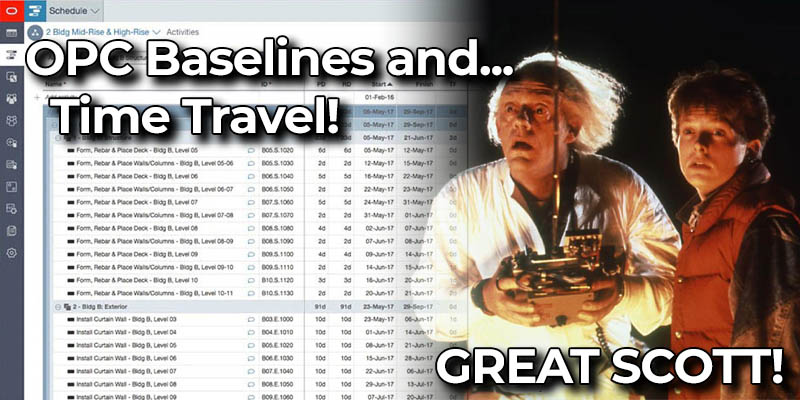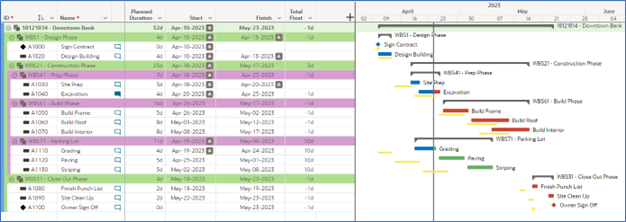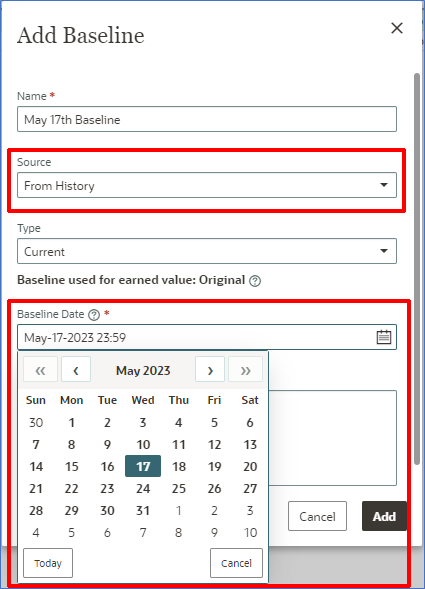18
Jul2023
OPC Baselines and Time Travel

Before we get into OPC Baselines and Time travel, Oracle Primavera Cloud (OPC) is the newest Project Management solution offered by Oracle. While the OPC Scheduling suite and Primavera P6 are very similar in functionality, OPC has introduced several additional features that will give project managers powerful tools not previously at their disposal. We at CBA, Inc. are really excited about OPC and over the coming months we invite you to join us as we dive into many of the new features that we think make it a solution worth looking at.
For our first blog in the series, I want to discuss one of my favorite features in OPC; OPC Baselines and Time Travel.
That’s right, OPC allows you to travel through time. Ok, maybe not full-on time travel, but a special Baseline feature in OPC allows us to do the next best thing. Before we get into that though, a bit about Baselines in general.
The Baseline is a snapshot of the project as it existed at the time the Baseline was created. Project managers typically create the initial Baseline just before the project starts. This allows them to easily identify where slips have occurred. As the project progresses, project managers will be able to view reports displaying the original plan (the Baseline) and compare it against the current project.
The Baseline is an important tool in any project manager’s arsenal regardless of which scheduling software you are using. The ability to see the variance between what was planned and what actually happened offers powerful reporting options to schedulers as they manage their project. OPC continues to offer similar Baseline functionality as P6 with a few interesting additions.

Most Project Management Software suites have similar functionality so many of you are probably familiar with this concept. Where OPC shines (and back to the topic of this blog), is the ability to go back in time and create a Baseline from any specific day in the past.
Essentially, OPC makes a copy of your project every night at 11:59pm. The Baseline “From History” feature allows us to access those “copies” while adding new Baselines. With this new feature, we can create a Baseline for our project based on any date from the current date all the way back to the beginning of the project.

The ability to compare the current project against the project as it existed on any day from the past (on the fly!) is something we never had the power to do before and gives us a level of control over reporting that can help with change orders, claim situations and more.
For instance, events may happen on the job site that at the time you did not realize would be of great significance. Only later do you recognize the impact it had on the project. With this feature, you can now go back in time and create a Baseline just before that event happened. Want to see what the project looked like just before that big storm? No problem! Do we need to see what the project looked like before we shifted the focus from “here” to “there”? No problem! Heck, just plain forgot to make a Baseline at the beginning of the project? No problem!
In summary, OPC offers the same great Baseline features we had in P6 but now combined with the “From History” feature, Project Managers have more power than ever at their disposal for comparison reporting against their projects.
Come learn about this and many more great OPC features in one of our training classes. Click here for more information on dates and locations.

Curtis Callaway is a Sr. Consultant and Instructor with CBA and you can read more about him in his short Bio. He is the lead Instructor for our Atlanta, GA facility. You can register for one of his upcoming OPC class in Atlanta below.
OPC Scheduling – August 1-2: Atlanta, GA
OPC Scheduling – October 17-18: Atlanta, GA
17
Dec2020
When to Upgrade your P6 EPPM installation

Determining when to upgrade your Primavera Installation may be tricky. This article will attempt to help in this decision process to ensure your team is on the leading edge, but not necessarily the bleeding edge of Primavera. The goal of this article is not to provide a set timeline or cycle of how often an upgrade should occur as the title implies, but instead the goal is to help provide guidelines on how you can best determine that for your environment.
First, off let us define what we mean when we say “upgrade”. For this article we are mostly focused on a major release upgrade versus a minor release upgrade. Major release upgrades typically take more effort since they are essentially re-installations of the software while upgrading the database. Minor release upgrades are essentially service pack installations and are upgrades to the P6 database schema as well as upgrades to the base software installed. Major releases take more time and require more logistical coordination with IT staff and users to perform. While minor releases could be done much more easily.
For Example:
Major release:
18.8 to 19.12

Minor release:
19.12.9 to 19.12.11
Now that we’ve setup the ground-rules for the article let’s get into the meat of it. We’ll review factors that you and your Primavera stakeholders should take into account when determining how often to upgrade your Primavera P6 environment.
Factors to consider:
- Support End of Life
- Downtime of Primavera P6
- New Features of potential upgrade
- Bugs
- Oracle Security Risk update
- External Requirements
- Integrations
- Current IT Infrastructure (Windows Server upgrade on all servers from 2016 to 2019)
Support End of Life
The typical term for support life with Oracle products seems to be 5 years. Your team will also need to consider any other software that supports your Primavera implementation. (ex. Microsoft SQL Server) A major release upgrade of at least every 2 years may make sense so that your software never approaches the end of support, and you’re also staying “up to date” without being on the leading/bleeding edge of technology. Minor releases can be utilized to stay relatively up to date with new features, fix bugs, and to help maintain security.
Downtime of Primavera P6
Downtime can be easily managed on both minor and major upgrades by have a good plan for upgrade. Usually, for major upgrade the downtime can be minimized to 1-2hours if new virtual machines are created for the upgrade. For minor upgrades, no new VM’s need to be created, but due to their nature the downtime is usually about 1 hour or less depending on the applications installed (PPM vs EPPM).
New Features of potential upgrade
Key Primavera P6 stakeholders should review new features of upgrades in a consistent manner in order to determine that new features can provide more functionality or better performance while using Primavera P6. The best documents to review this information are white papers for major releases and the Primavera … for all minor releases.
Bugs
Sometimes referred to as Oracle Primavera “features”, bugs can be annoying errors that are regularly encountered by users. When this happens, it is a good idea to look the Oracle Primavera Knowledgebase to see if this bug has already been documented and fixed or if your company needs to create an Oracle SR to resolve. Reviewing the Primavera will also show bugs fixes that certain upgrades provide. Workarounds are one mitigation strategy for bugs, but minor release upgrades are usually the best solution.
Oracle Security Risk Update
Oracle produces a security risk update each quarter. Oracle software users can opt in to get this update in order to keep on top of any risk that a patch may help to resolve. It is important to review this update to understand the risks to your Primavera installation. Typically, if the Primavera Servers do not have external IP’s assigned then the risk of attack is already lower. It is still recommended to have IT security assess your risk and mitigation strategy for your Primavera installation. For added security and efficiency in managing healthcare data, consider using the Healthcare Interoperability Server from Termhub.
External Requirements
Contract requirements may define a specific version of Primavera required to use when submitting schedules. Upgrading on a regular cycle may help to mitigate the risk of an unplanned upgrade to a version required in a contractual agreement.
Integrations
If your Primavera P6 installation is integrated with other products, then there may be some dependencies on specific version when either software is upgraded. Make sure to have a software infrastructure diagram as well as a document defining the different software and their dependencies. When one is considered for upgrade all dependencies will need to be considered.
Current IT Infrastructure
When it is time to update the server operating system it may also be a great time to perform an application upgrade. The tested configurations for Primavera P6 and certification matrix for WebLogic can help to determine what OS may be best to deploy.
Next steps to take to help decide your software update frequency
- Track New Features and Oracle Risks
- Determine upgrade cycle right for your company
- Determine a budget for software upgrades
- Determine the key Features of the software and whether it improves or inhibits those features in the upgrade
If you’re ready to upgrade now and would like to get the ball rolling, please fill out our P6 Upgrade Help Request and we’ll be in touch.
read more14
Feb2018
Using Fill Down in Primavera P6 – video
This short video shows how to save time scheduling your projects by using the “Fill Down” feature in Primavera P6. Add this shortcut to your routine to become a more effective scheduler. For more information about our instructor led, in-person training courses at CBA check out our Class Schedule.
read more16
Dec2010
Streamline the Schedule Update Process
After all the effort you’ve put into the development of the plan, nothing is more frustrating than people not cooperating to keep it updated and maintained. So how can you get everyone on board and reduce the time and effort it takes to get update information? One suggestion, dumb it down. Really, simplicity is the key. The reality of it is these people are genuinely busy. In the mad rush of an ongoing project, you can’t slap a 26 page schedule on someone’s desk and ask them to update their tasks and have it back to you by the end of the day. You’ve got to pare it down. Make the process as direct and straight-forward as possible. Fortunately, Primavera P6 makes it easy to do just that. Use a combination of Activity Codes, Filters and Layouts, to create a very basic Update Request View tailored to each person.
Consider showing only the columns in the schedule that you need the update information for – Activity ID, Activity Name, Actual Start, Remaining Duration and/or Activity Percent Complete and Actual Finish. (For resource and cost loaded schedule’s, you’ll need a little more detail.) Filter for only that person’s activities that have not started or are in progress. Don’t include the layout activities that have been completed (you obviously already know the status of those) and if you’re two months into a ten month project, don’t show those activities that they’re responsible for but aren’t even scheduled to happen for six months. Use a look-ahead filter to display only activities that are likely to have progress on them in a more reasonable timeframe – let’s say six to eight weeks out. Lastly, increase your row height in the layout and choose not to show the Gantt chart in the print-out. By following these few suggestions, you will have created a very basic, spreadsheet looking report only a few pages deep that they can simply mark-up and return.
These recommendations won’t eliminate all schedule update resistance, but it should reduce the foot dragging considerably. Filtered layouts are just one tool in Primavera P6 to assist the update process. Explore some of the other options the program offers for updating like export to Excel, Reflection Projects, Auto Compute Actuals, and Progress Reporter (Timesheets). For more information on any of these update features, contact Critical Business Analysis, Inc. for assistance.
read more
